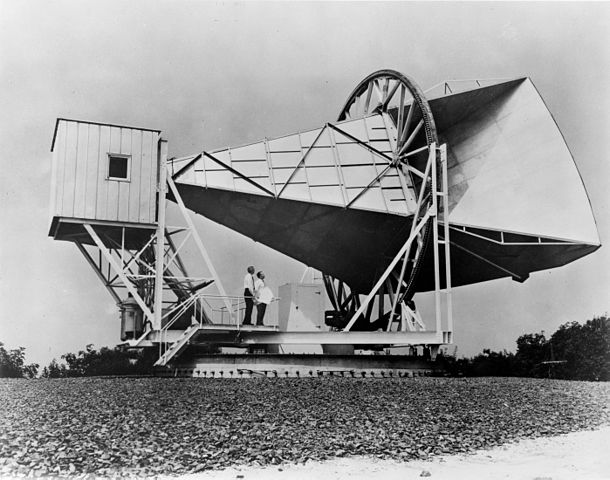 |
This is a file from the Wikimedia Commons. Information from its description page there is shown below.
Commons is a freely licensed media file repository. You can help.
|
 |
This is an image of a place or building that is listed on the National Register of Historic Places in the United States. Its reference number is 89002457.
|
Summary
| Description |
English: The 15 meter Holmdel horn antenna at Bell Telephone Laboratories in Holmdel, New Jersey was built in 1959 for pioneering work in communication satellites for the NASA ECHO I. The antenna was 50 feet in length and the entire structure weighed about 18 tons. It was comprised of aluminium with a steel base. It was used to detect radio waves that bounced off Project ECHO balloon satellites. The horn was later modified to work with the Telstar Communication Satellite frequencies as a receiver for broadcast signals from the satellite. In 1964, radio astronomers Robert Wilson and Arno Penzias discovered the cosmic microwave background radiation with it, for which they were awarded the 1978 Nobel prize in physics. In 1990 the horn was dedicated to the National Park Service as a National Historic Landmark. This type of antenna is called a Hogg or horn-reflector antenna, invented by Albert Beck and Harald Friis in 1941 and further developed by D. C. Hogg at Bell Labs in 1961. It consists of a flaring metal horn with a reflector mounted in the mouth at a 45° angle, so the antenna receives radio waves at a 90° angle to the horn axis. The reflector is a segment of a parabolic reflector, so the antenna is equivalent to a parabolic antenna fed off-axis. This type of antenna has characteristics that make it a good radio telescope: it has very broad bandwidth, the aperture efficiency can be calculated accurately, and the horn shields the antenna from electrical noise coming from angles outside the beam axis, so it picks up little thermal ground noise. |
| Date |
June 1962 |
| Source |
Great Images in NASA Description |
| Author |
NASA |
Permission
( Reusing this file) |
| Public domainPublic domainfalsefalse |
 |
This file is in the public domain because it was solely created by NASA. NASA copyright policy states that "NASA material is not protected by copyright unless noted". (See Template:PD-USGov, NASA copyright policy page or JPL Image Use Policy.) |
|
|
|
Warnings:
- Use of NASA logos, insignia and emblems are restricted per US law 14 CFR 1221.
- The NASA website hosts a large number of images from the Soviet/ Russian space agency, and other non-American space agencies. These are not necessarily in the public domain.
- Materials based on Hubble Space Telescope data may be copyrighted if they are not explicitly produced by the STScI. See also {{ PD-Hubble}} and {{ Cc-Hubble}}.
- The SOHO (ESA & NASA) joint project implies that all materials created by its probe are copyrighted and require permission for commercial non-educational use.
- Images featured on the Astronomy Picture of the Day (APOD) web site may be copyrighted.
|
|
|
Object location
|
40° 23′ 29.00″ N, 74° 11′ 7.00″ W
|
This and other images at their locations on: Google Maps - Google Earth - OpenStreetMap - Proximityrama |
( Info)40.391389;-74.185278 |
 |
This image or video was catalogued by NASA Headquarters of the United States National Aeronautics and Space Administration (NASA) under Photo ID: GPN-2003-00013 AND Alternate ID: 62-Tels-20.
This tag does not indicate the copyright status of the attached work. A normal copyright tag is still required. See Commons:Licensing for more information.
|
File usage
The following pages on Schools Wikipedia link to this image (list may be incomplete):
SOS Childrens Villages has brought Wikipedia to the classroom. SOS Children's Villages is famous for the love and shelter it brings to lone children, but we also support families in the areas around our Children's Villages, helping those who need us the most. Help another child by taking out a sponsorship





